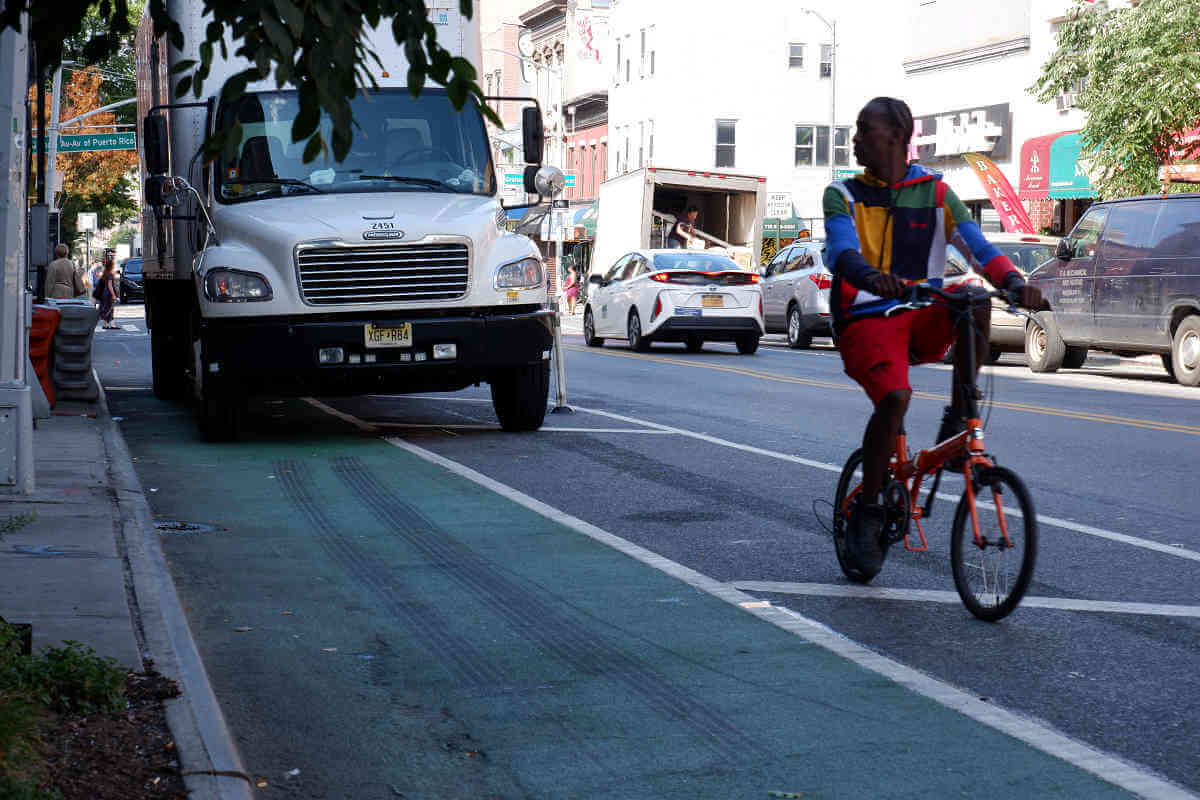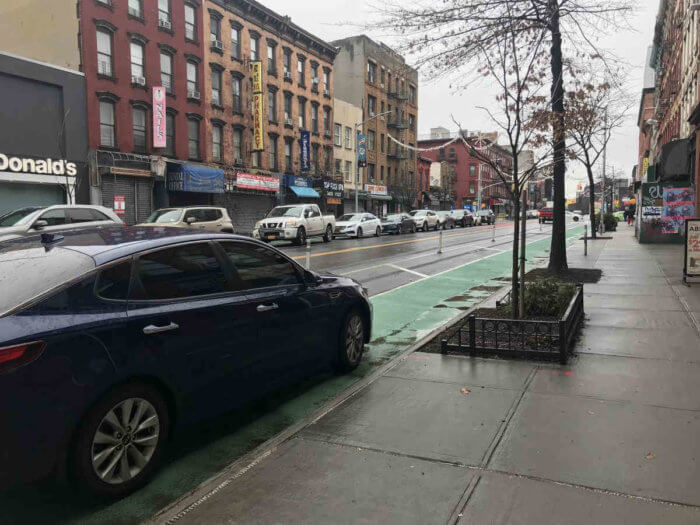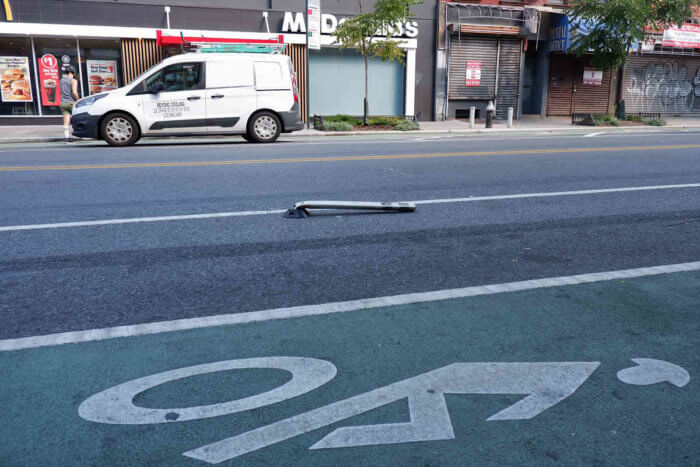Activists and electeds ask DOT to add better barriers to Grand Street bike lane • Brooklyn Paper
ACTIVISTS AND ELECTEDS ASK DOT TO ADD BETTER BARRIERS TO GRAND STREET BIKE LANE
By
Kirstyn Brendlen
Posted on
March 3, 2022
A cyclist rides in front of a truck illegally parked in the Grand Street bike lane in 2019. Activists are asking DOT to consider adding hardy concrete barriers to the lane to keep cyclists safer.
File photo by Joe Hinti
Sign up for our
amNY Sports email newsletter to get insights and game coverage for your favorite teams
Backed by a number of local elected officials, Brooklyn-based transportation activists are urging the city to install concrete barriers on the Grand Street bike lane in Williamsburg as part of the Department of Transportation’s plan to fortify protected bike lanes.
In a March 1 letter to Mayor Eric Adams and Department of Transportation Commissioner Ydanis Rodríguez, activists with the northern Brooklyn arm of Transportation Alternatives said the plastic bollards that currently protect the lane are insufficient and still allow vehicles to enter and block the lane, forcing cyclists into dangerous situations as they try to navigate around them.
“The Grand Street bike lane is one of the first of its kind in North Brooklyn, implemented along a vital east-west corridor. This is the product of years of community meetings and workshops, in response to the deaths of
Matt von Ohlen and
Rafael Nieves,” the letter says. “However, since 2019, the year of its full implementation, there have been 67 cyclist injuries along this ‘protected’ path with a total of 196 crashes across all modes of transportation. It is not a safe street for anyone, let alone a protected bike lane. “
To remedy the dangerous lane, the activists want DOT to add Grand Street to their list of bike lanes slated to be beefed up with four-ton concrete Jersey barriers.
Last month, the department announced that work had begun
installing those barriers on a number of heavily-trafficked lanes as part of a plan to “harden” half of the city’s 40 miles of protected bike lanes by the end of next year.
A car sits in the freshly-painted Grand Street bike lane in early 2019. Since the time the lane was started, cyclists have said that existing barriers are not enough to keep vehicles out of the lane.File photo by Julianne Cuba
At the time, the department had finished installing the barriers on two Manhattan bike lanes and was in the process of adding them to another, with plans to add the mammoth dividers to more lanes in Manhattan and Queens in coming months. Additional locations in Brooklyn and the Bronx are being considered for the program, according to the department, but none have been announced yet.
Delays in sourcing the concrete barriers have slowed down installation, according to DOT, so they’re searching for new sources and alternative materials.
“We’re working around the clock to harden the bike lanes we’ve already announced and appreciate the support for this important work,” said Vin Barone, a DOT spokesman. “We are considering locations across the city for future lane hardenings and will have more to share soon.”
“The Grand Street bike lane is an important connector in North Brooklyn, yet drivers routinely ignore the plastic delineators and treat the lane like a parking lot, putting bike riders and pedestrians at risk,” said Juan Serra, co-chair of the group’s Activist Committee. “Commissioner Rodriguez’s plan to fortify bike lanes is an important step to keeping riders safe, and we urge the City to prioritize Grand Street for safety investments. Grand Street can be a model bike lane for the whole city if it’s given the resources to succeed.”
Concerns about the safety of the lane began before it had even been completed, with neighborhood cyclists criticizing DOT for using a combination of paint, flexible plastic bollards, and rows of parked cars to separate cyclists from vehicle traffic rather than installing hardier barriers.
One of the thin plastic barriers at the Grand Street bike lane sits in the street after being hit by a car in 2019. Three years later, activists are hoping DOT will install concrete jersey barriers to truly protect the lane.File photo by Joe Hinti
In 2019, a FedEx driver told Brooklyn Paper he was
forced to stop in the bike lanes because the new designated loading zones, meant to help keep traffic flowing, were filled with illegally-parked private vehicles. Those private vehicles had also already broken several of the plastic barriers, leaving them useless in the street.
“During visioning sessions, the community requested safety and transportation improvements, including protective jersey barriers, dedicated loading zones, and a dedicated bus lane along Grand Street extending over the Williamsburg Bridge, none of which were implemented,” the letter reads. “We knew the omission of protective jersey barriers would lead to dangerous conditions back in 2019 and we have witnessed that prediction come tragically true throughout 2021.”
Even a 2020
spruce-up, where DOT installed some more substantial barriers, wasn’t enough to keep cars out of the lane.
The busy bike lane serves as a critical connection to the Williamsburg Bridge, and making it safer for cyclists is good for the neighborhood, the letter, which was signed by elected officials including Assemblymember Emily Gallagher, state Sen. Julia Salazar, Councilmember Lincoln Restler and Brooklyn Borough President Antonio Reynoso.
“To keep people safe, the Grand Street bike lanes need real protection that stops drivers from blocking the path,” said Kevin Costa, co-chair of the activist Committee. “As Commissioner Rodriguez and DOT announce plans to upgrade bike lanes across the city, we urge them to make Grand Street safe for bike riders with much-needed investments in concrete bike lane barriers.”


 how does that qualify as word games?
how does that qualify as word games?








